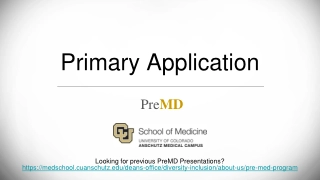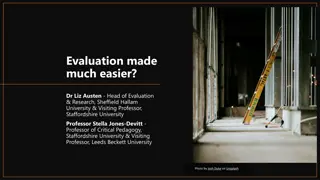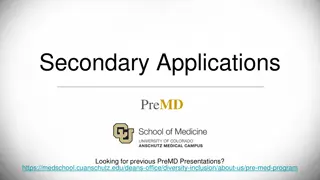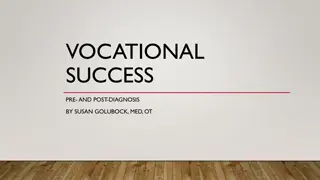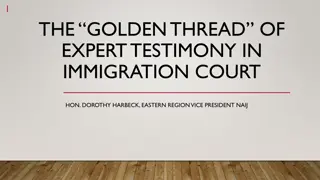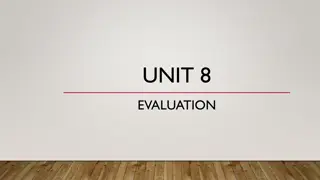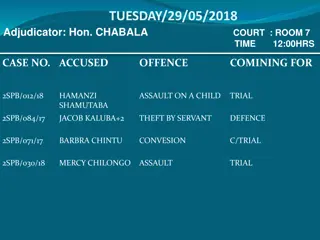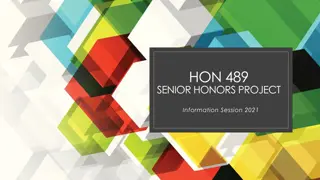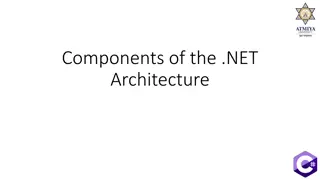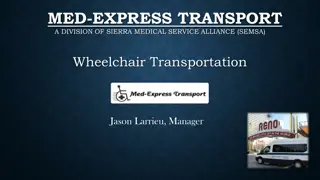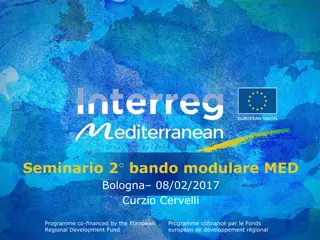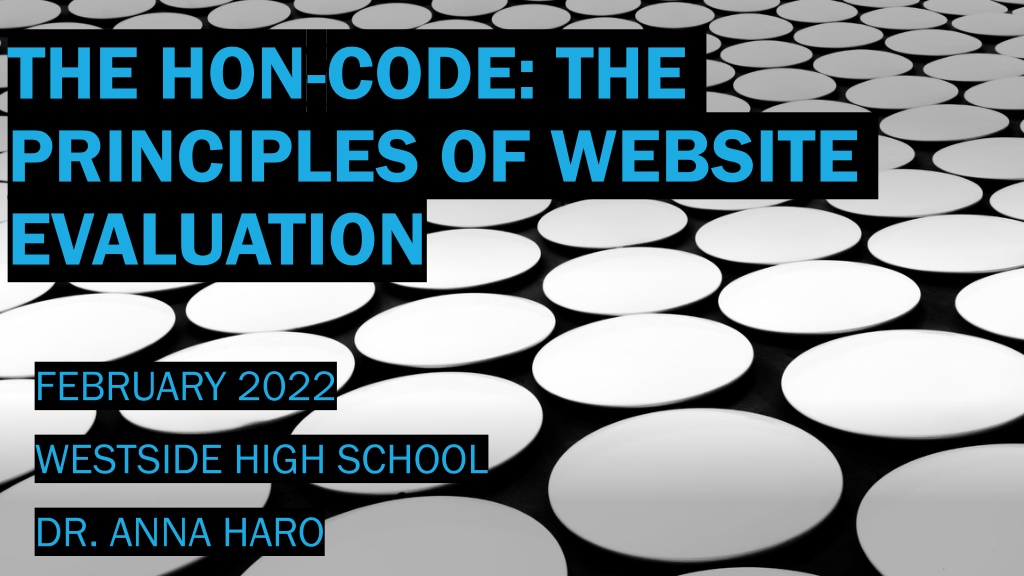
Understanding the HON-Code and Website Evaluation Principles
Explore the HON-Code, a tool for identifying reliable online health information, and delve into the principles of website evaluation. Learn about the importance, application, and challenges of internet evaluation skills. Discover the steps to search for information online, compare the HON-Code principles, and assess the opportunities they present.
Download Presentation

Please find below an Image/Link to download the presentation.
The content on the website is provided AS IS for your information and personal use only. It may not be sold, licensed, or shared on other websites without obtaining consent from the author. Download presentation by click this link. If you encounter any issues during the download, it is possible that the publisher has removed the file from their server.
E N D
Presentation Transcript
THE HON-CODE: THE PRINCIPLES OF WEBSITE EVALUATION FEBRUARY 2022 WESTSIDE HIGH SCHOOL DR. ANNA HARO
CONTACT INFO INFORMACI N DEL CONTACTO HISD Email: Website: https://www.houstonisd.org/Domain/52335 Website: Website: Website: https://www.houstonisd.org/Domain/52335 https://www.houstonisd https://www.houstonisd .org/Domain/52335 .org/Domain/52335 Anna.Haro@Houstonisd.org Anna.Haro@Houstonisd Anna.Haro@Houstonisd .org .org Website: https://www.houstonisd.org/Domain/52335 Anna.Haro@Houstonisd.org
LEARNING OBJECTIVES TEKS: 130.223. (c)(1)(A) & (B) 130.223. (c)(2)(A) & (B) 130.223. (c)(4)(A)(B) & (C) Students will compare and contrast the 8 HON-Code principles. Students will evaluate the steps and skills to search for CTE information on the Internet. Students will discuss the opportunities and challenges of teaching students how to develop internet evaluation skills.
OBJETIVOS DE APRENDIZAJE TEKS: 130.223. (c)(1)(A) & (B) 130.223. (c)(2)(A) & (B) 130.223. (c)(4)(A)(B) & (C) Los estudiantes comparar n y contrastar n los 8 principios del C digo HON. Los estudiantes evaluar n los pasos y habilidades para buscar informaci n CTE en Internet. Los estudiantes discutir n las oportunidades y desaf os de ense ar a los estudiantes c mo desarrollar habilidades para evaluar informaci n de la Internet.
A. The HON-Code 1. What? 2. Why? 3. How? OUTLINE B. The 8 HON-code principles 1. Authoritative, 2. Complementarity, 3. Privacy Policy, 4. Attribution, 5. Justification, 6. Transparency, 7. Financial Disclosure, 8. Advertising Policy C. Steps and skills to search for information on the Internet D. Opportunities and challenges
1. What is the HON-Code? HON = Health on the Net. A. THE HON-CODE FROM: HTTPS://WWW.HEALTHONNET .ORG/HONCODE/PRO/VISITO R/VISITOR.HTML#:~:TEXT=TH E%20HONCODE%20IS%20A%2 0CODE,THE%20NEEDS%20OF %20THE%20AUDIENCE. The HON-code is a private (non-governmental) and independent certification organization whose purpose is to help identify reliable and trustworthy information on the Internet. 2. Why is there an HON-code? How many health care information websites are on the Internet (English-language) websites? A. 50,000 websites B. 500,000 websites C. 5 million websites D. More than 500 million websites
2. Why is there an HON-code? How many health care information websites are on the Internet (English-language) websites? A. 50,000 websites B. 500,000 websites C. 5 million websitesD. More than 500 million websites The correct answer is letter D. The correct answer is letter D. More than 500 million healthcare information websites. A. THE HON-CODE In 2008, an independent research study sampled 140,000 different health care websites. They found a rate of misinformation and inaccurate health care information documented in more than __________ % of websites.
2. Why is there an HON-code? In 2008, an independent research study sampled 140,000 different health care websites. They found a rate of misinformation and inaccurate health care information documented in more than 95 % of websites. From: Faisal Hanif, Janet C. Read, John A. Goodacre, Afzal Chaudhry & Paul Gibbs (2009) The role of quality tools in assessing reliability of the Internet for health information, Informatics for Health and Social Care, 34:4, 231-243, DOI: 10.3109/17538150903359030 Extrapolating that accuracy rate to today s websites, then there are more than 475 million websites with inaccurate, misleading and or false information about health care!!! Patients and the lay-person are exposed to significantly more bad/wrong information about their health than good information. A. THE HON- CODE
3. How do students know which websites are valid, trustworthy, and reliable sources of health care information? Look for the HON-code certification. A. THE HON-CODE The certification does not guarantee accurate information, but it is the intent to provide the best and most up-to-date health care information as possible. Discussion question: Why doesn t the HON-code guarantee accurate information? Use evaluation and searching skills.
1. Authoritative Any medical or health advice provided and hosted on this site will only be given by medically trained and qualified professionals unless a clear statement is made that a piece of advice offered is from a non-medically qualified individual or organization. Discussion question: Would you choose website A or website B? 2. Complementarity The information provided on this site is designed to support, not replace, the relationship that exists between a patient/site visitor and his/her existing physician. B. 8 HON-CODE PRINCIPLES INFO: ACCESSED FROM HTTPS://WWW.HON.CH/CGI- BIN/HONCODE/PRINCIPLES.PL?ENGLIS H (30/SEPT/2020).
Disclaimer: The information discussed during the Mental Health Disorders Presentations is intended to inform and educate high school students. The presentations do not replace the advice and individualized care from a qualified mental health care provider. However, please know that I am available to listen should you or a friend need help. I will guide you to the counselors and social worker if needed, and I can provide fact-based answers and resources about your medications and treatment. SAMPLE DISCLAIMER
3. Privacy Confidentiality individual patients and visitors to a medical/health Web their identity, is respected by this Web site. The Web site owners undertake to honor or exceed requirements of information privacy that apply in the country and state where the Web site and mirror sites are located. of data relating to B. 8 HON-CODE PRINCIPLES INFO: ACCESSED FROM HTTPS://WWW.HON.CH/CGI- BIN/HONCODE/PRINCIPLES.PL ?ENGLISH (30/SEPT/2020). site, including the legal medical/health
4. Attribution Where appropriate, information contained on this site will be supported by clear references to source data and, where possible, have specific HTML links to that data. The date when a clinical page was last modified will be clearly displayed. 5. Justifiability Ask your students: What is the root word? Any claims relating to the benefits or performance of a specific treatment, commercial product or service will be supported by appropriate, balanced evidence in the manner outlined above in Principle 4. B. 8 HON-CODE PRINCIPLES INFO: ACCESSED FROM HTTPS://WWW.HON.CH/CGI- BIN/HONCODE/PRINCIPLES.PL ?ENGLISH (30/SEPT/2020).
6. Transparency The designers of this Web site will seek to provide information in the clearest possible manner and provide contact addresses for visitors that seek further information or support. The Webmaster will display his/her E-mail address clearly throughout the Web site. B. 8 HON-CODE PRINCIPLES INFO: ACCESSED FROM HTTPS://WWW.HON.CH/CGI- BIN/HONCODE/PRINCIPLES.PL ?ENGLISH (30/SEPT/2020).
7. Financial disclosure Support for this Web site will be clearly identified, including the identities of commercial and non-commercial organizations that have contributed funding, services or material for the site. 8. Advertising policy If advertising is a source of funding it will be clearly stated. A brief description of the advertising policy adopted by the Web site owners will be displayed on the site. Advertising and other promotional material will be presented to viewers in a manner and context that facilitates differentiation between it and the original material created by the institution operating the site. B. 8 HON-CODE PRINCIPLES INFO: ACCESSED FROM HTTPS://WWW.HON.CH/CGI- BIN/HONCODE/PRINCIPLES.PL ?ENGLISH (30/SEPT/2020).
A-L Discussion question: Why is it important to ask your students to consider the source of funding and B. 8 HON-CODE PRINCIPLES how advertisements are displayed? M-Z Discussion question: What different formats have websites used to display advertising? Why?
1. Always begin with the question. 2. Avoid bias in the search terms. There is a wide variation in results between the two searches: dangers of vaccines and vaccine safety. Consider using MeSH terms (MEdical Subject Headings). C. SEARCHING SKILLS: WHAT ARE THE STEPS? 3. Scan the first page of search results prior to clicking. (Do you see similar answers? Are there any reliable websites? Are there any bizarre results?) 4. Pitfall: AVOID Ads.
5. Click and scan the results for at least 3 websites to compare and contrast the content. (This scanning skill should be demonstrated to students.) C. SEARCHING SKILLS: WHAT ARE THE STEPS? Quickly scan the webpage for HON-code criteria. Ex. Privacy - Were you asked to fill out a questionnaire to access the information? Ad Policy - Are Ads embedded, disguised, or clearly off to the side? Authoritative -Who is the author? Transparency - Is the content organized? Etc.)
6. Choose the best website and search for the specific information to answer your question. 7. Document the search findings through paraphrasing. If students are in the gathering stage, it is okay to copy and paste the text and document it in quotes from a website. C. SEARCHING SKILLS: WHAT ARE THE STEPS? 8. Copy and paste the full website url or DOI and pair it with the answer before moving to the next website or next question. All references should be cited, for both paraphrasing and quotations.
Opportunities: 1. The HON-code principles provide a framework to build critical thinking skills (evaluating, analyzing, synthesizing) D. OPPORTUNITIES AND CHALLENGES 2. The 8 HON-code principles can be applied to searching and evaluating information for any topic. 3. Effective website searching skills follow students into their college, careers, and the military.
Challenges: 1. 8 that is a big number to learn and adapt. No fancy acronyms or monikers to memorize the principles or steps. 2. Using the 8 HON-code principles to evaluate information on the internet is a skill. It takes time and practice for students to become effective evaluators. 3. Information overload. Knowledge at the tips of their fingers! We take it for granted, but the volume can be overwhelming. D. OPPORTUNITIES AND CHALLENGES
CASE STUDY Your father/grandfather recently was hospitalized for STEMI. You are not sure what this means. You have heard the doctors say over and over again that something in his heart is completely blocked. After listening to your mother/grandmother, you realize she keeps saying STEMI and your dad/granddad is at risk for another AMI. Your mom/grandmother is 78 years old and doesn t know what to do or how to help. Discussion Question: what question will you first search on the Internet to help your loved ones?
CASE STUDY Discussion Question: what question(s) will you first search on the Internet to help your loved ones? What is a STEMI? What is an AMI? What are the signs and symptoms of an AMI? How do you prevent another AMI? What are the risks factors for STEMI or AMI? How is STEMI treated?
MAYOCLINIC.ORG EXAMPLE:
QUESTIONS? Type questions in the chat or: Email me: Anna.Haro@Houstonisd.org https://www.houstonisd.org/Domain/ 52335


